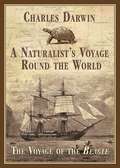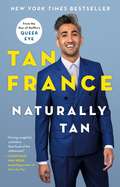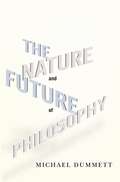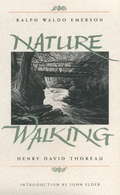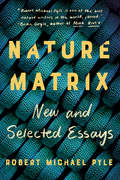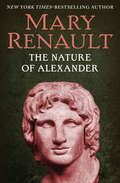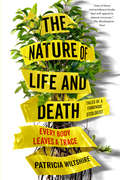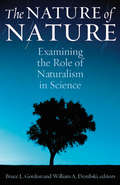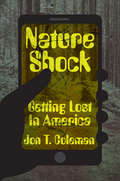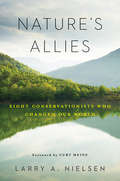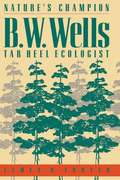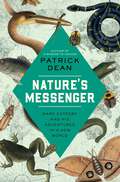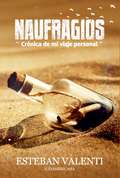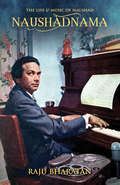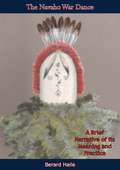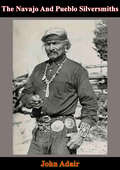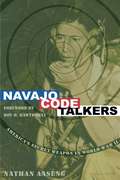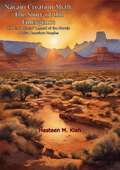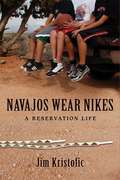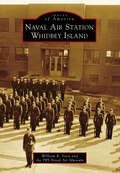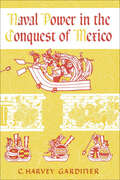- Table View
- List View
A Naturalist's Voyage Round the World: The Voyage of the Beagle
by Charles DarwinWhen On the Origin of Species came out in 1859, it changed the understanding of life and was the foundation of evolutionary biology. All the material that he received for this book was from the famous expeditions he took on the Beagle during the 1830s. This is the story of that voyage.A Naturalist's Voyage Round the World follows Charles Darwin over his almost five-year journey around the world, in which he studied animals, plants, geology, and much more. From the tip of South America and the Galapagos Islands to Australia and Tahiti, Darwin set out to study geology, but ended up finding the information that would lead to his theory of evolution by natural selection.With the original images from Darwin's journal, A Naturalist's Voyage Round the World is an incredible look into the past at one of the most important documentations of a sea voyage ever. The information collected by Darwin changed our world, and now you can relive every moment in his own words and illustrations.
Naturally Tan: A Memoir
by Tan FranceIn this heartfelt, funny, and touching memoir, one of the stars of Netflix’s Emmy Award-winning smash-hit Queer Eye reveals how an Englishman raised in a traditionally religious home became a fashion icon—and the first openly gay, South Asian man on television—simply by being Naturally Tan. <p><p> In this heartfelt, funny, touching memoir, Tan France tells his origin story for the first time. With his trademark wit, humor, and radical compassion, Tan reveals what it was like to grow up gay in a traditional South Asian family, as one of the few people of color in South Yorkshire, England. He illuminates his winding journey of coming of age, finding his voice (and style!), and marrying the love of his life—a Mormon cowboy from Salt Lake City. <p> From one of the stars of Netflix’s runaway hit show Queer Eye, Naturally Tan is so much more than fashion dos and don’ts—though of course Tan can’t resist steering everyone away from bootcut jeans! Full of candid observations about U.S. and U.K. cultural differences, what he sees when you slide into his DMs, celebrity encounters, and the behind-the-scenes realities of “reality TV,” Naturally Tan gives us Tan’s unique perspective on the happiness to be found in being yourself. <p> In Tan's own words, “The book is meant to spread joy, personal acceptance, and most of all understanding. Each of us is living our own private journey, and the more we know about each other, the healthier and happier the world will be.”
Naturally Tan: A Memoir
by Tan FranceA USA Today Hottest Book of the Summer for 2019!A Best Nonfiction Book for 2019 in Women's Day!One of Hello Giggles's "Most Anticipated Books of 2019 to Add to Your Reading List"!“Just when I thought I knew everything about Tan, he hits me with this. His story is so heartwarming, and wickedly funny.” —Antoni PorowskiIn this heartfelt, funny, and touching memoir, one of the stars of Netflix’s Emmy Award-winning smash-hit Queer Eye reveals how an Englishman raised in a traditionally religious home became a fashion icon—and the first openly gay, South Asian man on television—simply by being Naturally Tan.In this heartfelt, funny, touching memoir, Tan France tells his origin story for the first time. With his trademark wit, humor, and radical compassion, Tan reveals what it was like to grow up gay in a traditional South Asian family, as one of the few people of color in South Yorkshire, England. He illuminates his winding journey of coming of age, finding his voice (and style!), and marrying the love of his life—a Mormon cowboy from Salt Lake City. From one of the stars of Netflix’s runaway hit show Queer Eye, Naturally Tan is so much more than fashion dos and don’ts—though of course Tan can’t resist steering everyone away from bootcut jeans! Full of candid observations about U.S. and U.K. cultural differences, what he sees when you slide into his DMs, celebrity encounters, and the behind-the-scenes realities of “reality TV,” Naturally Tan gives us Tan’s unique perspective on the happiness to be found in being yourself.In Tan's own words, “The book is meant to spread joy, personal acceptance, and most of all understanding. Each of us is living our own private journey, and the more we know about each other, the healthier and happier the world will be.”
The Nature and Future of Philosophy (Columbia Themes in Philosophy)
by Michael DummettPhilosophy is a discipline that makes no observations, conducts no experiments, and needs no input from experience. It is an armchair subject, requiring only thought. Yet that thought can advance knowledge in unexpected directions, not only through the discovery of new facts but also through the enhancement of what we already know. Philosophy can clarify our vision of the world and provide exciting ways to interpret it.Of course, philosophy's unified purpose hasn't kept the discipline from splintering into warring camps. Departments all over the world are divided among analytical and continental schools, Heidegger, Hegel, and other major thinkers, challenging the growth of the discipline and obscuring its relevance and intent. Having spent decades teaching in American, Asian, African, and European universities, Michael Dummett has felt firsthand the fractured state of contemporary practice and the urgent need for reconciliation. Setting forth a proposal for renewal and reengagement, Dummett begins with the nature of philosophical inquiry as it has developed for centuries, especially its exceptional openness and perspective-which has, ironically, led to our present crisis. He discusses philosophy in relation to science, religion, morality, language, and meaning and recommends avenues for healing around a renewed investigation of mind, language, and thought. Employing his trademark frankness and accessibility, Dummett asks philosophers to resolve theoretical difference and reclaim the vital work of their practice.
The Nature and Future of Philosophy
by Michael DummettPhilosophy is a discipline that makes no observations, conducts no experiments, and needs no input from experience. It is an armchair subject, requiring only thought. Yet that thought can advance knowledge in unexpected directions, not only through the discovery of new facts but also through the enhancement of what we already know. Philosophy can clarify our vision of the world and provide exciting ways to interpret it. Of course, philosophy's unified purpose hasn't kept the discipline from splintering into warring camps. Departments all over the world are divided among analytical and continental schools, Heidegger, Hegel, and other major thinkers, challenging the growth of the discipline and obscuring its relevance and intent. Having spent decades teaching in American, Asian, African, and European universities, Michael Dummett has felt firsthand the fractured state of contemporary practice and the urgent need for reconciliation. Setting forth a proposal for renewal and reengagement, Dummett begins with the nature of philosophical inquiry as it has developed for centuries, especially its exceptional openness and perspective-which has, ironically, led to our present crisis. He discusses philosophy in relation to science, religion, morality, language, and meaning and recommends avenues for healing around a renewed investigation of mind, language, and thought. Employing his trademark frankness and accessibility, Dummett asks philosophers to resolve theoretical difference and reclaim the vital work of their practice.
Nature and Walking
by Henry David Thoreau Ralph Waldo EmersonTogether in one volume, Emerson's Nature and Thoreau's Walking, is writing that defines our distinctly American relationship to nature.
Nature Matrix: New and Selected Essays
by Robert Michael PyleNature Matrix is a gathering of some of Robert Michael Pyle’s most significant, original, and timely expressions of a life immersed in the natural world, in all its splendor, power, and perilNature Matrix: New and Selected Essays contains sixteen pieces that encompass the philosophy, ethic, and aesthetic of Robert Michael Pyle. The essays range from Pyle’s experience as a young national park ranger in the Sierra Nevada to the streets of Manhattan; from the suburban jungle to the tangles of the written word; and from the phenomenon of Bigfoot to that of the Big Year—a personal exercise in extreme birding and butterflying. They include deep profiles of John Jacob Astor I and Vladimir Nabokov, as well as excursions into wild places with teachers, children, and writers.The nature of real wilderness in modern times comes under Pyle’s lens, as does reconsideration of his trademark concept, “the extinction of experience”—maybe the greatest threat of alienation from the living world that we face today.Nature Matrix shows a way back toward possible integration with the world, as it plumbs the range and depth of experience in one lucky life lived in close connection to the physical earth and its denizens. This collection brings together the thoughts and hopes of one of our most widely read and respected natural philosophers as he seeks to summarize a life devoted to conservation.
The Nature of Alexander
by Mary RenaultAn &“intriguing and invaluable&” biography of Alexander the Great by the novelist whose fiction redefined Ancient Greece (The New York Times). Acclaimed writer Mary Renault is widely known for her provocative historical novels of Alexander the Great and his lovers. But she also authored this nonfiction classic, a fresh, illuminating look at a man whose legend has remained larger than life for more than two thousand years. From his dysfunctional family dynamics to his molding under Aristotle, from his shocking rise to power at age twenty to the staggering violence of his military campaigns, Renault is clear-eyed about Alexander&’s accomplishments and his flaws. Infectious in its enthusiasm, this is a penetrating study of an unrivaled conqueror, enduring icon, and fascinating man. Hailed as both &“a splendid achievement in nonfiction&” (The Plain Dealer) and &“the perfect companion to her Alexander novels&” (The Wall Street Journal), Renault&’s engrossing and accessible biography stands alone in the pantheon of Alexander the Great literature.This ebook features an illustrated biography of Mary Renault including rare images of the author.
The Nature of Life and Death: Every Body Leaves a Trace
by Patricia WiltshireA riveting blend of science writing and true-crime narrative that explores the valuable but often shocking interface between crime and nature--and the secrets each can reveal about the other--from a pioneer in forensic ecology and a trailblazing female scientist.From mud tracks on a quiet country road to dirt specks on the soles of walking boots, forensic ecologist Patricia Wiltshire uses her decades of scientific expertise to find often-overlooked clues left behind by criminal activity. She detects evidence and eliminates hypotheses armed with little more than a microscope, eventually developing a compelling thesis of the who, what, how, and when of a crime. Wiltshire's remarkable accuracy has made her one of the most in-demand police consultants in the world, and her curiosity, humility, and passion for the truth have guided her every step of the way.A riveting blend of science writing and true-crime narrative, The Nature of Life and Death details Wiltshire's unique journey from college professor to crime fighter: solving murders, locating corpses, and exonerating the falsely accused. Along the way, she introduces us to the unseen world all around us and underneath our feet: plants, animals, pollen, spores, fungi, and microbes that we move through every day. Her story is a testament to the power of persistence and reveals how our relationship with the vast natural world reaches far deeper than we might think.
The Nature of Nature: Examining the Role of Naturalism in Science
by William Dembski Bruce GordonThe intellectual and cultural battles now raging over theism and atheism, conservatism and secular progressivism, dualism and monism, realism and antirealism, and transcendent reality versus material reality extend even into the scientific disciplines. This stunning new volume captures this titanic clash of worldviews among those who have thought most deeply about the nature of science and of the universe itself.Unmatched in its breadth and scope, The Nature of Nature brings together some of the most influential scientists, scholars, and public intellectuals--including three Nobel laureates--across a wide spectrum of disciplines and schools of thought. Here they grapple with a perennial question that has been made all the more pressing by recent advances in the natural sciences: Is the fundamental explanatory principle of the universe, life, and self-conscious awareness to be found in inanimate matter or immaterial mind? The answers found in this book have profound implications for what it means to do science, what it means to be human, and what the future holds for all of us.
Nature Shock: Getting Lost in America
by Jon T. ColemanAn award‑winning environmental historian explores American history through wrenching, tragic, and sometimes humorous stories of getting lost The human species has a propensity for getting lost. The American people, inhabiting a mental landscape shaped by their attempts to plant roots and to break free, are no exception. In this engaging book, environmental historian Jon Coleman bypasses the trailblazers so often described in American history to follow instead the strays and drifters who went missing. From Hernando de Soto&’s failed quest for riches in the American southeast to the recent trend of getting lost as a therapeutic escape from modernity, this book details a unique history of location and movement as well as the confrontations that occur when our physical and mental conceptions of space become disjointed. Whether we get lost in the woods, the plains, or the digital grid, Coleman argues that getting lost allows us to see wilderness anew and connect with generations across five centuries to discover a surprising and edgy American identity.
Nature's Allies: Eight Conservationists Who Changed Our World
by Larry NielsenIt's easy to feel powerless in the face of big environmental challenges—but we need inspiration more than ever. With political leaders who deny climate change, species that are fighting for their very survival, and the planet's last places of wilderness growing smaller and smaller, what can a single person do? InNature's Allies, Larry Nielsen uses the stories of conservation pioneers to show that through passion and perseverance, we can each be a positive force for change.In eight engaging and diverse biographies—John Muir, Ding Darling,Aldo Leopold, Rachel Carson, Chico Mendes,Billy Frank Jr., Wangari Maathai, and Gro Harlem Brundtland—we meet individuals who have little in common except that they all made a lasting mark on our world. Some famous and some little known to readers, they spoke out to protect wilderness, wildlife, fisheries, rainforests, and wetlands. They fought for social justice and exposed polluting practices. They marched, wrote books, testified before Congress, performed acts of civil disobedience, and, in one case, were martyred for their defense of nature.Nature's Alliespays tribute to them all as it rallies a new generation of conservationists to follow in their footsteps.These vivid biographies are essential reading for anyone who wants to fight for the environment against today's political opposition. Nature's Allies will inspire students, conservationists, and nature lovers to speak up for nature and show the power of one person to make a difference.
Nature's Champion
by James R. TroyerThrough the pioneering efforts of ecologist B. W. Wells (1884-1978), thousands of North Carolinians learned to appreciate and protect the state's diverse plant life long before ecology and conservation became popular causes. A keen observer of the natural landscape, Wells provided the first scientific descriptions in modern terms of the forces that shaped coastal communities, bogs and savannahs, the Carolina bays, pine forests, old fields, and mountain grassy balds. But the broader impact of his life lay in his championship and popularization of nature. Outside academic circles, he shared his knowledge through public lectures, articles, and lobbying efforts, and by teaching anyone who would listen. In 1932 he produced for his Tar Heel audience a revolutionary work on the plant ecology of the state, The Natural Gardens of North Carolina. Organized by habitat, this volume is still entertaining and instructive. Wells received his Ph.D. in botany from the University of Chicago in 1917 and served as chair of the North Carolina State College botany department for thirty years. He was a memorable teacher and a significant force in the development of his academic institution.
Nature's Messenger: Mark Catesby and His Adventures in a New World
by Patrick DeanA dynamic and fresh exploration of the naturalist Mark Catesby—who predated John James Audubon by nearly a century— and his influence on how we understand American wildlife.In 1722, Mark Catesby stepped ashore in Charles Town in the Carolina colony. Over the next four years, this young naturalist made history as he explored deep into America&’s natural wonders, collecting and drawing plants and animals which had never been seen back in the Old World. Nine years later Catesby produced his magnificent and groundbreaking book, The Natural History of Carolina, the first-ever illustrated account of American flora and fauna. In Nature&’s Messenger, acclaimed writer Patrick Dean follows Catesby from his youth as a landed gentleman in rural England to his early work as a naturalist and his adventurous travels. A pioneer in many ways, Catesby&’s careful attention to the knowledge of non-Europeans in America—the enslaved Africans and Native Americans who had their own sources of food and medicine from nature—set him apart from others of his time. Nature&’s Messenger takes us from the rice plantations of the Carolina Lowcountry to the bustling coffeehouses of 18th-century England, from the sun-drenched islands of the Bahamas to the austere meeting-rooms of London&’s Royal Society, then presided over by Isaac Newton. It was a time of discovery, of intellectual ferment, and of the rise of the British Empire. And there on history&’s leading edge, recording the extraordinary and often violent mingling of cultures as well as of nature, was Mark Catesby. Intensively researched and thrillingly told, Nature&’s Messenger will thrill fans of exploration and early American history as well as appeal to birdwatchers, botanists, and anyone fascinated by the natural world.
Naufragios: Crónica de mi viaje personal
by Esteban ValentiPersonaje polémico si los hay, Esteban Valenti se propone abrir esta "ventana de sinceridad" para exponer su camino vital, no exento de contradicciones, fallos y desengaños. Esteban Valenti plantea en este libro una revisión de su vida, las peripecias que ha tenido a lo largo de los años, y su participación en el accionar político desde diversos ámbitos. Se revela como una personalidad compleja, por momentos contradictoria, que ha dedicado la mayor parte de su existencia a la participación en la actividad política. Este libro finaliza analizando el fracaso del proyecto La Alternativa, y revelando los pormenores de ese proceso.
Naushadnama: The Life and Music of Naushad
by Raju BharatanThe seven letters in Naushad’s name are like the seven notes of Hindustani classical music. After just a few years in films, Naushad (1919-2006) went to rule the Hindi cinema music world for around two decades, beginning with the landmark Rattan (1944). His oeuvre (from 1940 to 2005) consists of an unmatched list of jubilees, many of which are musical milestones such as Andaz (1949), Baiju Bawra (1952), Mother India (1957) and Mughal-e-Azam (1960).No individual stays supreme without putting in tremendous efforts to reach the pinnacle and to stay there as long as possible, as our maestro did. And no composer probably moved so cleverly, behind the scenes, than did Naushad to sustain his hold on the public imagination. Although we continue to marvel at the incredible variety of his mellifluous creations that have withstood the test of time, how little most of us know about Naushad the man. Renowned song historian Raju Bharatan fleshes out the real Naushad – his triumphs and tragedies – bringing into play more than 50 years of personal interaction with the tuneful titan. In the process, the author makes the book more sparking with a string of anecdotal gems. For instance: • How Naushad and his contemporaries despite their professed bonhomie, were fiercely competitive (both musically and monetarily) in their attempts to occupy the ‘top spot’. • How many days of rehearsal were needed for some of the Baiju Bawara masterpieces? • How the immortal compositions of Mughal-e-Azam were recorded in a studio no better than a tin shed.This volume also throws new light on the relations and interactions between Naushad and his singers (especially Suraiya, Mohammed Rafi, Lata Mangeshkar, Asha Bhosle and Shamshad Begum); his songwriters (mainly D.N Madhok, Shakeel Badayuni and Majrooh Sultanpuri); and his ‘unsung’ instrumentalists (some of whom were geniuses in their own right).
NAUSHADNAMA The Life and Music of Naushad: The Life And Music Of Naushad
by Raju BharatanNaushad is by popular consent the greatest among our film music composers, having been active for 65 years! For twenty years during that period, he ruled the field: from Rattan in 1944, he was the standard against whom every other composer tried to match himself! He didn't have much to show by way of originality after Mughal e Azam (1961), though his music never became base : it was only that the stars for whom he composed declined, the public taste changed, he became trapped in his own image as the custodian of the classical mould in film sangeet. It is a measure of the great man that he steadily refused to succumb to the market pressure. His composing abilities were never in question, but he could not give 'hits" or tunes that would appeal.When he tried to adjust, he was pathetic. Raju Bharatan is such an authority on Naushad and our film music, with so much first hand knowledge and information, a book from him on Naushad is likely to be the last word as an account of his professional life. But this book covers so much more: what the cine music filed was like from inside, how the composers were competing , how they were bad-mouthing Naushad in private, in spite of the show of public bonhomie, what devious games were played to corner awards and limelight, etc. The point is not the filmi world was so dirty; the point is that the composers created great music even in such atmosphere.
Nautilus 90 North
by William R. Anderson Clay Blair"Nautilus 90 North," the navigator reported to the ship's commanding officer. It was 11:15 pm, August 3, 1958, and the U.S.S. Nautilus, the world's first nuclear-powered submarine, was at the geographical North Pole ... From the dark waters of Puget Sound, Nautilus headed north toward the achievement of two historic goals-- piercing the Pole and the completion of the first transpolar voyage from the Pacific to the Atlantic. Intricate preparations carried out under strictest secrecy behind them, the crew learned for the first time that the previously announced trip to Panama was a coverup. Commander William R. Anderson vividly recreates life aboard the atomic submarine. He tells of the suspense of Top Secret orders, the human and humorous incidents that passed the time of the crew, and the unparalleled adventure of the first probe when the Nautilus came within 180 miles of the North Pole and fulfilled the Jules Verne dream in steaming its 20,000th league under the sea. He shares with you the excitement and tension of the preparations, mishaps and repairs, omens good and bad, that filled the days before the dramatic announcement of destination North Pole was made. Commander Anderson relates, with the immediacy of his on-the-scene participation in each moment, the narrow escapes, the special problems of navigation that had to be overcome, how special instruments were installed in secrecy, the "cover plan" that kept the whole Navy mum, and finally the incredible adventure itself. "A tense, thrilling story of a daring exploit." --Chicago Sunday Tribune This is the true story of one of the most daring adventures of all time--the voyage of the Nautilus across the North Pole--under the Arctic ice pack. Told by Commander William R. Anderson, this is a spine-tingling story of the men and the ship who made modern history by opening, with one bold stroke, a new Northwest passage across the top of the world in an epic voyage that to this day has not been duplicated. Here are the narrow escapes, the mishaps and repairs, the jokes and excitement ... each thrilling event just as it happened ... in what was, in Commander Anderson's own words "...one of the most dramatic, historic, and challenging sea adventures of all time."
The Navaho War Dance: A Brief Narrative of its Meaning and Practice
by Berard HaileExplains the meanings and customary forms of the Navajo war dance, including information on the drums and rattle sticks, the progression of the dance through each of its three days, and the different roles of the various participants.
The Navajo And Pueblo Silversmiths (The\civilization Of The American Indian Ser. #25)
by John AdairProbably no native American handicrafts are more widely admired than Navajo weaving and Navajo and Pueblo silver work. This book contains the first full and authoritative account of the Indian silver jewelry fashioned in the Southwest by the Navajo and the Zuni, Hopi, and other Pueblo peoples. It is written by John Adair, a trained ethnologist who has become a recognized expert on this craft."A volume conspicuously pleasing in its format and so strikingly handsome in its profuse illustrations as to rivet your attention once it chances to fall open. With the care of a meticulous and thorough scholar, the author has told the story of his several years' investigation of jewelry making among the Southwestern Indians. So richly decorative are the plates he uses for his numerous illustrations showing the jewelry itself, the Indians working at it and the Indians wearing it--that the conscientious narrative is surrounded by an atmosphere of genuinely exciting visual experience."--The Dallas Times HeraldThe Navajo and Pueblo Silversmiths provides a full history of the craft and the actual names and localities of the pioneer craftsmen who introduced the art of the silversmith to their people. Despite its present high stage of development, with its many subtle and often exquisite designs, the art of working silver is not an ancient one among the Navajo and Pueblo Indians. There are men still living today who remember the very first silversmiths.
Navajo Code Talkers
by Nathan Aaseng<p>On the Pacific front during World War II, strange messages were picked up by American and Japanese forces on land and at sea. The messages were totally unintelligible to everyone except a small select group within the Marine Corps: the Navajo code talkers-a group of Navajos communicating in a code based on the Navajo language. This code, the first unbreakable one in U.S. history, was a key reason that the Allies were able to win in the Pacific. <p>Navajo Code Talkers tells the story of the special group, who proved themselves to be among the bravest, most valuable, and most loyal of American soldiers during World War II.</p>
Navajo Creation Myth: The Story Of The Emergence - The Din� Bahane' Legend Of The Navajo Native American Peoples
by Hasteen M. KlahThe Navajo creation myth, called the Diné Bahaneʼ, is one of the greatest stories of the Native American peoples, filled with evocative images of nature and wondrous storytelling.Hasteen M. Klah was a Navajo medicine man who grew up among the culture, whereby ceremonial events and sandpainting were a direct expression of the people’s beliefs. Over the course of his life he sought to write down the various myths of his people, plus the ritual events and songs. The greatest challenge Klah faced was relating the entirety of the creation myth - being true and accurate to the Navajo peoples, but understandable to readers unaccustomed to such an immense religion.The reader will find the complexity and intricacy of their spiritual lore rewarding; this book contains not only the full narration of the Diné Bahaneʼ, but also the verses sung by the Navajo during the telling of the story. We hear further parts of the creation myth; stories whereby gigantic beasts lay claim to parts of the world, influencing the ancient Navajo tribe’s affinity with nature and its creatures. Towards the conclusion, Klah includes further songs that celebrate the Earth, or commemorate certain occasions and ceremonies. Lastly, there is a lengthy glossary explaining the many names and terms used in the mythos.
Navajos Wear Nikes: A Reservation Life
by Jim KristoficJust before starting second grade, Jim Kristofic moved from Pittsburgh across the country to Ganado, Arizona, when his mother took a job at a hospital on the Navajo Reservation. Navajos Wear Nikes reveals the complexity of modern life on the Navajo Reservation, a world where Anglo and Navajo coexisted in a tenuous truce. After the births of his Navajo half-siblings, Jim and his family moved off the Reservation to an Arizona border town where they struggled to readapt to an Anglo world that no longer felt like home. With tales of gangs and skinwalkers, an Indian Boy Scout troop, a fanatical Sunday school teacher, and the author's own experience of sincere friendships that lead to (beautiful harmony), Kristofic's memoir is an honest portrait of growing up on--and growing to love--the Reservation.
Naval Air Station Whidbey Island (Images of America)
by William R. Stein the PBY-Naval Air MuseumNaval Air Station (NAS) Whidbey Island in Washington State has a long and storied history that began in 1942 and continues to the present day. Tucked away on an island that is its namesake, NAS Whidbey was originally conceptualized as a small support base for an existing air station in nearby Seattle. That prewar plan was rapidly eclipsed by world events, and the proposed support base quickly evolved into an air station of its own right. Through historic photographs chosen from the archives of the US Navy, the PBY-Naval Air Museum, and the personnel of NAS Whidbey Island, both past and present, the story of the air station is told. These images will serve not only as a trip down memory lane for those stationed at Whidbey in days gone by, but will also illustrate to younger generations their connection to those who served in the not so distant past.
Naval Power in the Conquest of Mexico
by C. Harvey GardinerIn this account of the naval aspect of Hernando Cortés''s invasion of the Aztec Empire, C. Harvey Gardiner has added another dimension to the drama of Spanish conquest of the New World and to Cortés himself as a military strategist. The use of ships, in the climactic moment of the Spanish-Aztec clash, which brought about the fall of Tenochtitlán and consequently of all of Mexico, though discussed briefly in former English-language accounts of the struggle, had never before been detailed and brought into a perspective that reveals its true significance. Gardiner, on the basis of previously unexploited sixteenth-century source materials, has written a historical revision that is as colorful as it is authoritative. Four centuries before the term was coined, Cortés, in the key years of 1520-1521, used the technique of "total war. " He was able to do so victoriously primarily because of his courage in taking a gamble and his brilliance in tactical planning, but these qualities might well have signified nothing without the fortunate presence in his forces of a master shipwright, Martin López. As the exciting story unrolls, Cortés, López, and the many other participants in the venture of creating and using a navy in the midst of the New World mountains and forests are seen as real personalities, not embalmed historical stereotypes, and the indigenous defenders are revealed as complex human beings facing huge odds. Much of the tale is told in the actual words of the protagonists; Gardiner has probed letters, court records, and other contemporary documents. He has also compared this naval feat of the Spaniards with other maritime events from ancient times to the present. Naval Power in the Conquest of Mexico as a book was itself the result of an interesting combination of circumstances. C. Harvey Gardiner, as teacher, scholar, and writer, had long been interested in Latin American history generally and Mexican history in particular. During World War II, from 1942 to 1946, he served with the U. S. Navy. As he relates: "One day in early autumn 1945, while loafing on the bow of a naval vessel knifing its way southward in the Pacific a few degrees north of the Equator, my thoughts turned to the naval side of the just-ended conflict, and in time the question emerged, ''I wonder how the little ships and the little men will fare in the eventual record?'' Then, because I was eager to return to my civilian life of pursuit of Latin American themes, the concomitant question came: ''I wonder what little fighting ships and minor men of early Latin America have been consigned to the oblivion of historical neglect?'' As I began later to rummage my way from Columbus toward modem times, I seized upon the Mexican Conquest as the prime period with pay dirt for the researcher in quest of the answer to that latter question. "In this account of the naval aspect of Hernando Cortés''s invasion of the Aztec Empire, C. Harvey Gardiner has added another dimension to the drama of Spanish conquest of the New World and to Cortés himself as a military strategist. The use of ships, in the climactic moment of the Spanish-Aztec clash, which brought about the fall of Tenochtitlán and consequently of all of Mexico, though discussed briefly in former English-language accounts of the struggle, had never before been detailed and brought into a perspective that reveals its true significance. Gardiner, on the basis of previously unexploited sixteenth-century source materials, has written a historical revision that is as colorful as it is authoritative. Four centuries before the term was coined, Cortés, in the key years of 1520-1521, used the technique of "total war. " He was able to do so victoriously primarily because of his courage in taking a gamble and his brilliance in tactical planning, but these qualities might well have signified nothing without the fortunate presence in his forces of a master shipwright, Martin López. As the exciting story unrolls, Cortés, López, and the many other participants in the venture of creating and using a navy in...
